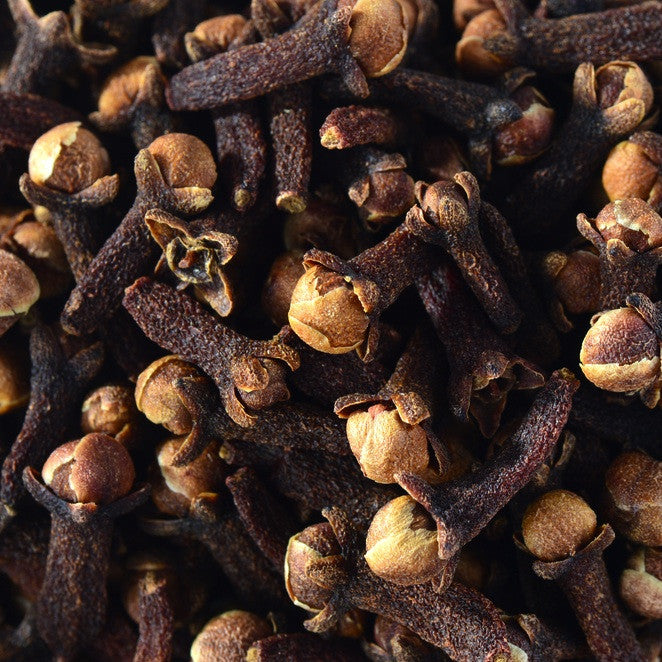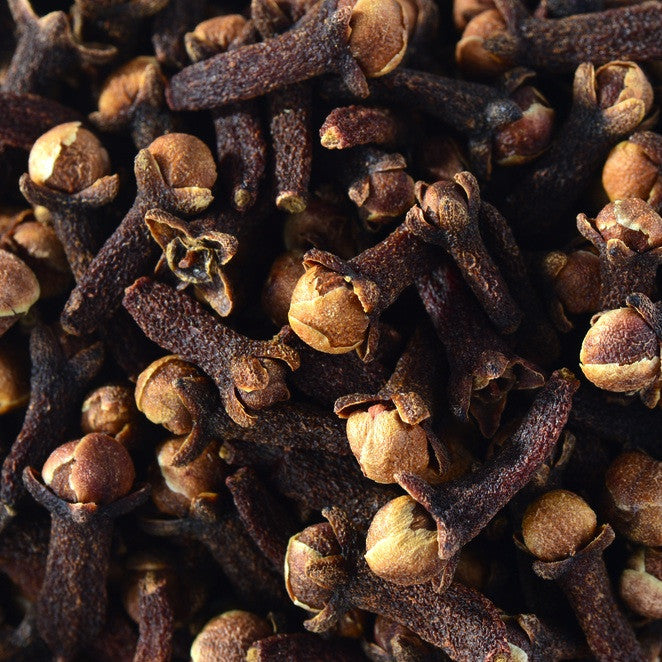TIMELESS Essential Oils
Clove Bud
Couldn't load pickup availability
Pure Therapeutic Clove Bud essential oil
Product Details
Botanical name
Eugenia caryophyllata (Eugenia aromatica), Syzygium aromaticum
Extraction method / Source
Steam distillation of the dried flower bud and stem
Aroma
Spicy, sweet
Note
Top, Middle
Odor Intensity
5
Key constituents
Eugenol, eugenyl acetate, caryophyllene
Plant description
Botanical family: Oleaceae (Myrtaceae)
Clove is a tropical evergreen tree indigenous to Indonesia. It grows to a height of about 40-60 feet, and has aromatic dark green leathery leaves and rosy pink buds that bloom into bright red flowers, followed by purple berries. Clove trees are long-lived, and are reported to remain productive for 150 years. Clove trees were introduced to Zanzibar, now Tanzania, in the 19th century, and that region has become the world leader in exports of clove.
Regions of Production
Indonesia
Growing Practices
Cultivated without the use of chemical fertilizers or pesticides.
History / Fun Facts
The first recorded use of Clove was in China, around 220 BC, where it was used to freshen the mouth. Clove became popular in Europe in the 13th Century after being introduced by Marco Polo. For years, Eugenol, Clove's primary constituent, was used by dentists to numb the mouth. In 1990, a group of medical researchers demonstrated that a solution of 0.05% Eugenol from Clove oil killed tuberculosis bacilli. Clove oil is reputed to be part of the legendary "Four Thieves Vinegar". See our version of this amazing essential oil blend, TIMELESS Thieves Oil .
Properties
Anesthetic, analgesic, anti-aging, antibacterial, anti-fungal, antimicrobial, antiseptic, antiviral, anti-inflammatory, relieves flatulence, expectorant, insect repellent
Please refer to the Glossary for terms which may be new to you.
Uses / Benefits
Warming, improves circulation, useful for pain relief for arthritis, rheumatism and sprains. Beneficial for cold and flu prevention, throat infections and general mouth care. Helps manage symptoms of asthma and bronchitis. Clove oil is numbing for all kinds of pain, and is frequently used for toothache. Undiluted clove oil applied directly to an aching tooth and surrounding area will give pain relief for several hours. Stimulates the appetite, improves digestion and helps relieve flatulence (gas). Repels lice and scabies.
Fragrant influences
Mental stimulant - use with Peppermint essential oil to alleviate drowsiness, promotes dreaming, improves sleep, aphrodisiac
Modes of Administration
Topical: bath, massage, compress, ointment
Oral Care: Use neat (undiluted) for pain relief, 1 - 2% in water for antiseptic mouthwash
Inhalation: direct inhalation, diffuser
Blends well with
Bay, Benzoin, Chamomile, Clary Sage, Geranium, Ginger, Grapefruit, Jasmine, Lavender, Lemon, Mandarin, Palmarosa, Sandalwood, Ylang Ylang
Safety
Not for use internally, except in cooking. Non toxic in doses used in aromatherapy. May be irritating and sensitizing to the skin. May enhance the effects of Warfarin, aspirin and other prescription blood thinners. Avoid in pregnancy and for children under 6 years. Do not use if you have cancer.
Notice
This information is for educational purposes only. It has not been evaluated by the US Food and Drug Administration. It is not intended to diagnose, treat, cure or prevent any condition or disease, and should not take the place of evaluation by a qualified health professional. Although we strive to provide information which is accurate and up to date, we cannot guarantee the accuracy or completeness of this information.
Precautions
Pure essential oils are highly concentrated plant extracts. Do not use them undiluted, or in the eyes or mucus membranes. If applying an essential oil to the skin, always dilute it with a proper carrier oil and test on a small patch of skin before applying to a large area. Do not take them internally except under the direction of a qualified professional trained in Aromatherapy. Always familiarize yourself with the safety, contraindications and proper preparation of each essential oil before use. Note that when using essential oils for children and the elderly, very low concentrations should be used. Keep all essential oils away from children and pets.
References
Althea Press, Essential Oils : Natural Remedies, 2015. Althea Press, Berkeley, CA.
Battaglia, Salvatore, The Complete Guide to Aromatherapy, Second Edition, 2003. The International Centre of Holistic Aromatherapy, Brisbane, Australia
Cooksley, Valerie Gennari, Aromatherapy: Soothing Remedies to Restore, Rejuvenate, and Heal, 2002. Prentice Hall Press, New York, NY.
Cooksley, Valerie Gennari, Aromatherapy : A Holistic Guide to Natural Healing with Essential Oils, 2015. Floramed Publishing, The Woodlands, TX.
International Fragrance Research Association, http://www.ifraorg.org/en-us/standards (January 5, 2016).
Schnaubelt, Kurt, Advanced Aromatherapy : The Science of Essential Oil Therapy, 1995. Healing Arts Press, Rochester, VT.
Schnaubelt, Kurt, The Healing Intelligence of Essential Oils : The Science of Aromatherapy, 2011. Healing Arts Press, Rochester, VT.
United States Food and Drug Administration, HHS, 182.1 Substances That Are Generally Recognized as Safe, 182.20 Essential oils, Oleoresins (solvent-free), and natural extractives (including distillates), http://www.gpo.gov/fdsys/CFR-2012-title21-vol3-sec182 (January 28, 2016).
Worwood, Valerie Ann, The Complete Book of Essential Oils & Aromatherapy, 1991. New World Library, Novato, CA.
TIMELESS Essential Oils guarantees the purity and quality of all our therapeutic oils. The current Certificate of Analysis is available upon request. All essential oils are best stored in an airtight container away from heat and light.


